Royal way of La Valdavia
The Camino Real de la Valdavia (English translation Royal way of La Valdavia) is a historical route that joins the Way of St. James as it passes through Carrión de los Condes, with the Piedrasluengas pass through the valley of the Valdavia, and which was known and represented as such on maps until recent times.[1]
.jpg)
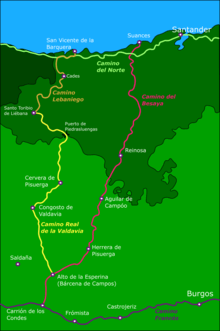
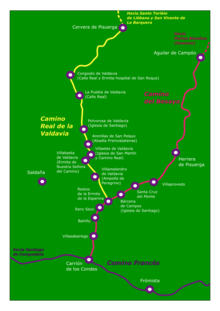
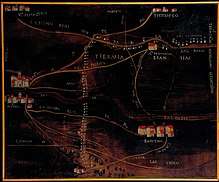
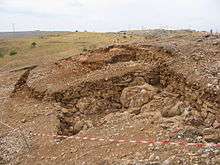
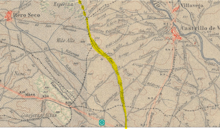
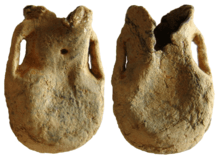
.jpg)
.jpg)
In addition to the vía Vadiniense and the ruta del Besaya, the ancient Cantabrian people and the rest of the people who reached the northern coast by boat knew another way of communicating with the fertile Castilian Plateau. This is the Camino Real de la Valdavia. This route allows the devout traveller the opportunity to visit two of the most important Christian pilgrimage centres in Spain, the Santiago de Compostela Cathedral and the monastery of Santo Toribio de Liébana.
This route starts at the seaport of San Vicente de la Barquera and crosses the Piedrasluengas pass, entering the Valdavia valley parallel to the Valdavia River until it joins the Besaya route at the alto de la Esperina near Carrión de los Condes.
This old road has several references that prove its antiquity and use. This is due to the fact that the aforementioned valley is the shortest and most accessible route from Carrión to the sea through the Piedrasluengas pass, which has allowed the movement of people and goods from Castile to the Cantabrian Sea since secular times.
Historical references
Thus, in a 1230 landing of the monastery of Saint Zoilus in Carrión de los Condes about their possessions in Villasarracino, the race to Villaeles is already being talked about.[2]
There is also news of this race, or road, in 1523 when Fernando Colón, son of Cristóbal Colón, published his Cosmografía with the most important routes of the time. Among these he details the one that goes from Toledo to San Vicente de la Barquera, of 80 leagues, where we see that after passing through the Province of Avila and the Province of Valladolid, it arrives to Palencia, It continues through Becerril de Campos and Torre de los Molinos to Carrión and from there it goes to Bahillo, Villabasta, Polvorosa, La Puebla and Cervera, and from here it reached San Vicente through Tudanca.[3]
In 1746, this royal road is represented in detail as it passes through the town of Bárcena de Campos[4] as a result of a lawsuit between the Council of Castrillo de Villavega and the Council of Bárcena over the jurisdiction of the territory in which the chapel of Nuestra Señora de Esperina was located. Here we can see how the Camino Real de la Valdavia passes at the foot of the aforementioned chapel, projecting towards two uninhabited areas of the current Villanuño de Valdavia called Villán de Suso and Villán de Yuso.
Still in the map of the Army of 1929,[1] there was the reference of the Camino Real de la Valdavia leaving from Villasarracino towards North. Even today at the exit of Villaeles, towards Congosto, there is a road called Camino Real, which becomes Calle Real as it passes through both La Puebla and Congosto.
Roadmap
The royal road of Valdavia itself would go from Congosto to Villasarracino. However, if we talk about the Jacobean route that makes use of it and links San Vicente de la Barquera with Carrión, we can trace the following route. From north to south the route would start from the seaport of San Vicente in the direction of either Potes by the Hermida Gorge, which is known as the Liébana route, or by the route of the old Roman road, known as Via II2, which going up by the Nansa would reach Tudanca.[5]
Both routes would converge in the ascent on its north side to the Piedraslenguas pass, from where it would go into La Pernía Palencia, passing through San Cebrián de Mudá and arriving at Cervera de Pisuerga.[6] There it would go towards Cantoral de la Peña, where it would cross the headwaters of the Boedo river leaving it behind, continuing until Roscales de la Peña, to get to Congosto de Valdavia[7] to the height of the old Venta del Cuerno.
At this point it would go along the left bank of the river Valdavia for what is still known as the royal road (to the point that the main streets of Congosto and La Puebla receive the significant name of Calle Real). This route takes advantage of the route of the old Via III which went up the left bank of the Valdavia and which linked Clunia, Castrojeriz, Potes, reaching the sea.[8] Arriving at Buenavista, it would continue through Polvorosa de Valdavia where the Church of Santiago is located, Renedo de Valdavia, Arenillas de San Pelayo with its magnificent Monastery Premostratense and Villaeles with its church of San Martín de Tours, a French saint of marked Jacobean tradition.
In Villaeles he would cross the river to Villabasta where the Chapel of the Virgin of the Way was located, now disappeared, but whose image is still venerated in its parish to continue towards Villamelendro. It is built around the Calle Mayor and gives it its characteristic elongated shape around the road. From Villamelendro it would leave by the camino de las arnillas towards the Villanuño's Villanes. On the banks of this path a medieval lead pilgrim's ampoule was found by chance in 2006.
Once past Los Villanes, he would reach the foothills of the Esperina, where there was a hermitage erected at the end of silo XII by the Countess Doña Mayor de Lara[9] widow of the Count Fernando Núñez de Lara. There it would join the route of the Besaya, which would explain the said foundation being a strategic communications knot, in the direction of Itero Seco, Bahillo and finally Carrión de los Condes where it would connect in turn with the French route.
Heritage of the route
Like the two other routes mentioned, this route offers a remarkable variety of landscapes and culture as it is the link between the ports of the Cantabrian Sea and the Castilian Plateau. This route is the shortest way for those pilgrims who will pass to worship the Lignum Crucis to continue towards Santiago de Compostela by the French Way. The orography of the Valdavia valley itself is a natural and accessible way of penetrating the valley.
The present route of this historic road coincides in part with the ancient Roman road known as Via III.[10] Thus, in Castro de la Loma we can see the encirclement and destruction of a large Cantabrian civitas, which is why we speculate that the Valdavia was one of the incursion routes from the barracks established by Octavio Augusto in Sasamón. But this is not the only Roman vestige, remains of vici appear along the Valdavia, testifying to the human presence from remote times in this area.
Outstanding are the Romanesque monuments of the first order that mark the way, such as the Lebanza Abbey and its famous capitals conserved in the Fogg Art Museum in Boston, [11] the collegiate church of San Salvador, the Romanesque church of the caserío de Tablares or the monasterio premostatense de San Pelayo.
See also
References
- "Iberpix 4". www.ign.es.
- Pérez Celada, Julio Antonio (1986). Documentation of the Monastery of San Zoilo de Carrión (1047-1300) - Document 96. Burgos Ediciones J.M. Garrido Garrido. p. 1234. ISBN 84-86371-09-0.
- Colón, Fernando (1988). Descripción y cosmografía de España / por Fernando Colón ; manuscript from the Colombina Library. Sevilla: Padilla Libros. ISBN 8487039073.
- "MINISTRY OF CULTURE AND SPORT - Portal de Archivos Españoles". pairs.mcu.es. Retrieved 3 January 2019.
- Solana Sáinz, José María (1981). The Cantabrians and the city of Iulóbriga. Bookshop studio edition. p. 228. ISBN 8485429206.
VIA II2: CORREPOCO-PIEDRASLENGUAS-CERVERA DE PISUERGA. From the Santa Lucía bridge it ascended to the line of peaks that separated the valleys of Saja and Nansa. At the Valsemana pass there are remains of a road leading from Santotís, Tudanca, Lombaña, Tresabuela, Salceda, La Cruz de Cabezuela, Sierra Mediana, Piedrasluengas...
- Solana Sáinz, José María (1981). Los Cántabros y la ciudad de Iulóbriga. Bookshop studio edition. p. 228. ISBN 8485429206.
VIA II2: CORREPOCO-PIEDRASLENGUAS-CERVERA DE PISUERGA...From here it would descend towards the S. through Redondo, Tremaya, possibly to Valsadornín, where a Roman numerary was found, Cervera de Pisuerga to join the previously mentioned II1.
- Solana Sáinz, José María (1981). Los Cántabros y la ciudad de Iulóbriga. Ediciones de librería studio. p. 227. ISBN 8485429206.
VIA II1: SALCEDILLO-CERVERA DE PISUERGA ... From this point (Cervera) we can give two possibilities: one by Cantoral, Castrejón de la Peña, Aviñante and Guardo (Via III). The other by (Cantoral) Boedo, Roscales and Congosto (Via III)...
- Solana Sáinz, José María (1981). The Cantabrians and the City of Iulóbriga. Bookshop studio edition. p. 223. ISBN 8485429206.
VIA III: CLUNIA-CASTROJERIZ-POTES-MAR CANTÁBRICO. ... It would pass the Pisuerga River by a bridge to the N. of Osorno, and would follow the left bank of the Valdavia River through Villavega, Villaeles, Buenavista, La Puebla, Congosto, Respenda and Guardo.
- Domínguez Aparicio, Jesús (2011). Bárcena de Campos historical approach. Diputación de Palencia. p. 80. ISBN 978-84-8173-173-6.
In effect, The first data we have about the hermit dates back to June 1232....The fundamental historical source of Esperina corresponds to a diploma, in whose dispositive part Major, Countess of Lara, together with her three children, Álvaro, Sanca and Teresa Fernández, make donation of the Church of Santa María de Esperina, with all the properties attached to it, to the abbot and brotherhoods of the brotherhood that resided in its walls.
- Solana Sáinz, José María (1981). The Cantabrians and the city of Iulóbriga. Bookshop studio edition. p. 223. ISBN 8485429206.
VIA III: CLUNIA-CASTROJERIZ-POTES-MAR CANTÁBRICO. ...I would continue by Velilla, where there is a Roman bridge, Camporredondo, Alba, Puente Temblo, Aruz, Dobres, Vega de Liébana and Potes. From this place it would follow, more or less, the current road until arriving to Unquera. I do not rule out the possibility that in Puente Teblo, or its vicinity, there was a road to Polentinos and Vañes to connect with the II2.
- "A Peek into Our Collections: Capital from Abbey of Santa María de Lebanza | Index Magazine | Harvard Art Museums". www.harvardartmuseums.org.